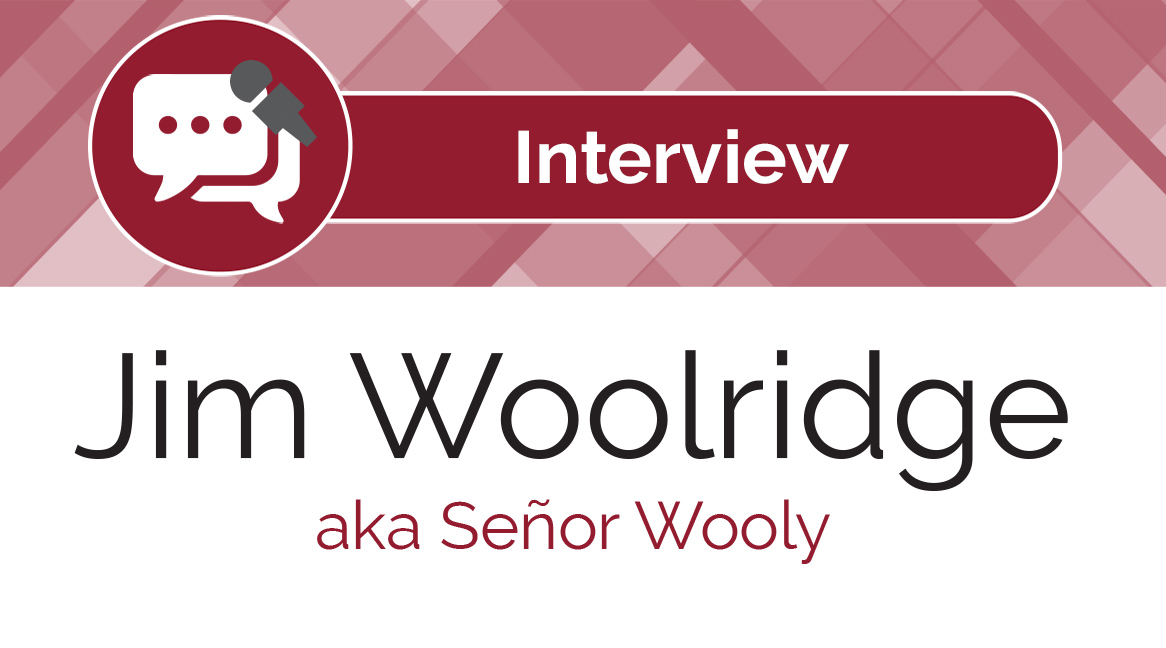Interview with Jim Woolridge, aka Señor Wooly
 By Adrienne Gonzales, Associate Director of the Center for World Languages and Cultures, University of Denver.
By Adrienne Gonzales, Associate Director of the Center for World Languages and Cultures, University of Denver.
Jim Woolridge is the creator of Señor Wooly, a music website for Spanish teachers and learners that provides comprehensible input through “funny, creative, and absurd stories with unexpected twists.
DOI: https://www.doi.org/10.69732/EWOT5114
Adrienne Gonzales: Can you introduce yourself and talk a little bit about your background as a teacher?

Jim Woolridge: My name is Jim Woolridge, and I taught in Evanston, IL, middle school spanish for about ten years. I didn’t think I would be a Spanish teacher. I didn’t really love my Spanish education that much growing up. It wasn’t my favorite class or anything like that, and I never imagined that I’d fall in love with the language. But as is typical with a lot of language students, I found myself living in Costa Rica, and I fell in love with it there. I truly fell in love with the language when I found out how remarkable and amazing it is to just communicate with someone in another language, but I never thought that I’d like sharing it with someone else. I know that sounds kind of strange to say, but I got my teaching endorsement in both Spanish and theater, and theater was a true passion of mine. I always assumed that because theater was always my favorite class, that theater was what I would want to teach. But the strangest thing happened: I got the opportunity to do both, and I didn’t really like teaching the theater that much. I found that I couldn’t surprise students with what thater could be. Students came in with a lot of preconceived notions about what theater could be, and I found it hard to break them of their perceptions. But with Spanish, I found I could totally surprise them with how remarkable and amazing it could be, and I fell in love with sharing Spanish. So I fell in love with it, I stopped teaching theater, and I devoted myself to teaching Spanish full time. I still love theater, but I don’t regret for a second that I got to become a Spanish teacher, and certainly over the years I’ve been able to infuse my teaching with my love of the theatrical.
About 3-4 years into teaching I started to create a lot of small songs and videos for my students. They were all very grammar-based, conjugation songs and things like that. The only audience that I had were my own students and my poor, tortured wife who had to watch everything that I made. But my students seemed to really get a kick out of it, and so they asked me to put it up on the internet. This was kind of the early days of YouTube, when it wasn’t as easily accessible, so I said, “You know what? I’m just going to make a website.” So I made a website, and other teachers somehow, I still don’t know how, found it and started using it, and before you know it, I had people using materials that I created. And how flattering is that? To make something and realize that people actually like it. So I did a little bit more and a little bit more, and at one point I said, “You know what? I’ll put out a CD of music,” and that sold really well among Spanish teachers. That’s kind of how I got started. A couple years after that, I officially formed the company Señor Wooly. Señor Wooly now has grown to the point where we have thousands and thousands of Spanish teachers all across the world using it, and over 10,000 classrooms a day are using the site. And while I love teaching, I’m not teaching right now because it grew to be a full-time business. It’s bittersweet leaving teaching, because I adore it.
Adrienne Gonzales: How did music come to play a role in your teaching?
Jim Woolridge: I grew up playing piano from second grade through high school, and I don’t know that I ever considered myself a great musician. I could play sheet music that was put in front of me and do some decent improvisation, but I went to college at Lawrence University (which has this amazing music conservatory), I compared myself with people there and whoa, not even close. Music was 100% purely for me.
But it’s kind of amazing how the stuff that you do when you’re younger, the stuff that you do maybe for two years or maybe for ten years, that stuff is still knowledge. It still becomes part of who you are, and it manifests itself in ways that you would never imagine. I’m not active in the Chicago theater community anymore, and then here I am doing theater through these videos. I wasn’t playing piano much anymore. In fact, my skills had significantly dropped off since I’d stopped practicing regularly, and yet I still had this musical sense that I wouldn’t have had, had I not been playing when I was younger.
When I started, I wasn’t trying to impress anybody, but Apple came out with a program called GarageBand, and GarageBand is a great little program. You can record directly into it, but you can also just take one of their thousands of pre-recorded loops and make simple short little ditties to use in class, and that’s how I started doing it. I wasn’t trying to do anything other than come up with some cool beat that I could use as a background and teach whatever concept or help with memory.
https://www.youtube.com/watch?v=mpmb-xTpAb4
I did that for a little while before I realized, “Wait a second, I can do a little more than this,” and I started tinkering. I pulled out the keyboard, started doing a little bit more, and I think with every song I started to put a little bit more of myself into it, to the point that now, yesterday, we were recording a new song with a full band. We played everything live. Vocals, guitar, drums, piano, upright bass, and five musicians playing together live, all in one take, and it’s just amazing. If you had told me five years ago that I’d be doing that, I would have laughed. Clearly I cannot do that. I am not a musician, and in many ways, I’m still very much an amateur musician, but it’s these baby steps that I took that got me to where I am now.
Adrienne Gonzales: What is it about music that helps students connect to content?
Jim Woolridge: Music has something that almost nothing else has. Repetition is one of the fundamental tenants of language acquisition. They say that to really truly acquire a word or structure you need to hear it between 75 to 150 times, and of course that doesn’t count a phrase that’s just thrown out there without meaning. I do not believe that language is something that can be acquired through osmosis just being around the language. A student hears a phrase or structure 75-150 times and understands it, and only then can they naturally begin to acquire that language and produce that language without effort. The problem with repetition is that repetition is fundamentally boring. The word repetitive itself sounds like a negative thing.
Young kids are different. My daughter is four, and I could read her the same book 100 times, and she’ll want it more and more, and that’s an amazing thing. But as they get older, kids don’t want to see the same content over and over again. I think that why I chose music as a vessel for language, because music is one of the only areas in which repetition is viewed as an asset. The chorus in a song is an appealing thing because it’s an invitation to join in. It’s an invitation for listeners to go, “Oh yeah, I get to be a part of this.” So I think that music is a fantastic way to deliver the comprehensible input, so that they can truly acquire the language. The only downside with music, and this is why this requires a teacher, is that it is not in and of itself necessarily comprehensible. You can listen to a song hundreds of times without understanding a single word. There are other things in music to latch onto other than just the meaning of the song itself. We’ve all had songs where we’ve listened to lyrics and not understood a single word. Or not even not understanding, but completely misunderstanding what the words are. That’s why if teachers are going to use music for delivering language input, they need to do all the comprehension checks make sure the students are understanding what they’re hearing. That’s also why I believe in not just using catchy music, but using music that has a strong story.
If you can give them that repetition in music but then combine that with a compelling story, especially in a music video where you can have the words telling a different part of the story and not having those two things necessarily overlap, then you’ve got it all. You’ve got your repetition in the music, you’ve got your visual story (which is going to get all kids no matter their language level), and then you couple that with simple Spanish that they’re going to want to understand to get texture and detail that’s not provided with the visuals. You get it all right there, and that’s why I’ve latched on to this idea of telling stories through music videos.
Señor Wooly was recently in the recording studio and will be releasing new songs soon!


Seriously? This is why teachers and people quit trying to do anything. Your comment is a perfect example of why teachers are leaving the field. I am sure you can make a unit just as good as his and there will be nothing that we can critique, nitpick and criticize and find some racial disparity with.
Spanish is a beautiful language and am proud to have been raised in a Mexican Spanish speaking home and appreciate your passion for the language. Music videos are fun although why in “puedo ir al baño?” Video do you Mr. Woolridge use a person of color beg a Caucasian teacher for permission use of restroom. Then a Caucasian student is granted permission when asked same question? What message are you sending?
Please clarify